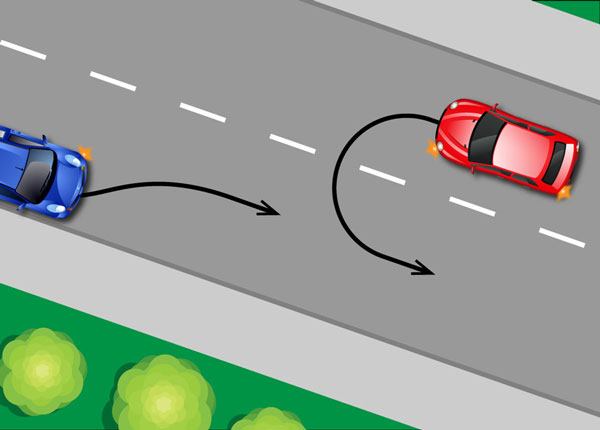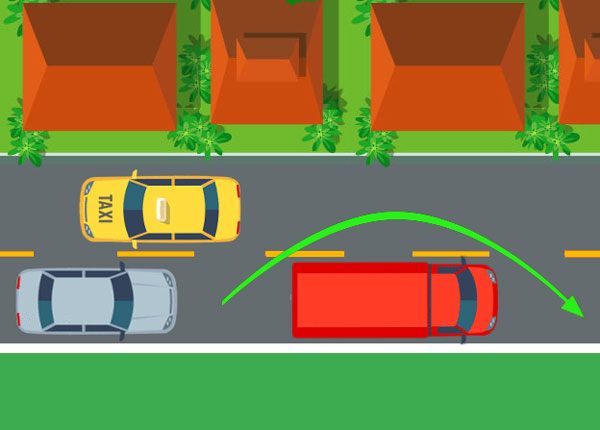
U-Turn How To: Step-by-Step Turnabout & Avoiding Illegal U-Turns
Updated Oct. 30, 2020Making a U-turn is the quickest and easiest way to turn your vehicle around should you need to reverse your direction of travel. This may happen if you find you are traveling in the wrong direction or if you accidentally overshoot your destination.
There are a variety of different turn maneuvers you can use to get yourself back on track on such occasions, each of which is appropriate in different situations. U-turns are the simplest of these maneuvers, as they can be executed in one smooth movement. You may need to make a two-point or three-point turn instead of a U-turn if the road is too narrow or if U-turns are prohibited for another reason.
Your ability to make a U-turn will likely be assessed during the practical road test. Learn how and when to execute a U-turn correctly before you visit your local DMV test site.
Making a U-turn on rural roads
Before making a U-turn, you must consider whether it is legal to do so. U-turns are generally prohibited in business districts, on highways and on curved stretches of road. Making a U-turn should be fine on a straight, rural road. In this situation, follow the steps below to complete the turn:
- 1

Bring your vehicle to a complete stop on the right side of the street. Use your right turn signal or a hand signal to indicate your intention to turn.
- 2

A gap in traffic of at least 200 feet is required to make a U-turn. Check for approaching motorists in both directions before starting the maneuver.
- 3

When you have enough space, drive forward slowly while turning the steering wheel left.
- 4

Cross the dividing line between lanes, then center your vehicle in the middle of the right lane.
- 5

Straighten your wheels once your car is centered in the right lane. Switch off your signal lights.
- 6

Accelerate to complete the maneuver and continue your journey.
Making a U-turn at an intersection
There is far more to think about when making a U-turn at an intersection, as you must observe traffic control signals. Plus, it is likely there will be more drivers on the road than there would be in a rural area. Check that there is not a “NO U-TURN” sign at the intersection before proceeding with the steps below:
- 1

When making a U-turn at an intersection, you should begin the maneuver in the furthest left lane, as close to the central lane as possible. Engage your left turn indicator light.
- 2

Watch the traffic signals and proceed only when a solid green light or green left-pointing arrow are present. Do not make a U-turn under a red traffic light.
- 3

A solid green signal means you must yield to pedestrians and motorists moving in the opposite direction before turning. When a green arrow is present your turn is protected, which means all opposing traffic should be halted by a red light. Check for oncoming traffic regardless of which signal you are dealing with, taking care to yield to drivers who are already passing through the intersection.
- 4

Drive forward and turn the steering wheel left to execute the U-turn. Finish the maneuver in the furthest lane to the right.
If the signal light changes from green to red while you are part way through the U-turn, do not stop and reverse back to the intersection. As soon as you have pulled away to begin the turn, you must see it through to the end. There should still be plenty of time to do this if you began when the signal was green. Simply continue forward and complete the turn in a controlled and timely manner.
Illegal U-turn
You will find the most relevant information about prohibited U-turns and turnabouts in your state’s driving handbook. The restrictions listed below apply across the board, though there may be further restrictions that apply to drivers in your state. Make sure you read this section of the manual to find out when turnabouts are and are not permitted.
Generally, U-turns are illegal when:
- A “NO U-TURN” sign is present.
- You are on a split highway with no gap in the central divide to allow a U-turn.
- Poor weather conditions, a hill or a bend in the road prevent you from seeing at least 200 feet in both directions.
- You are traveling on a one-way street.
- Traffic is heavy or you are traveling in a business district. Here, only U-turns at permitted intersections are allowed.
As with all turns, U-turns are best practiced in a clear open space such as a vacant parking lot, before you attempt them on a public road. Once you become more familiar with the turning radius of your vehicle and the time it takes to complete a U-turn, you can give them a try elsewhere. Remember to choose a spot on the road with a low volume of traffic and good visibility in both directions.




